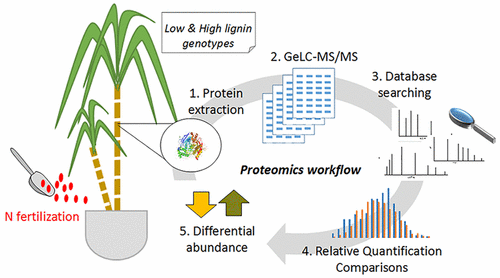当前位置:
X-MOL 学术
›
J. Proteome Res.
›
论文详情
Our official English website, www.x-mol.net, welcomes your
feedback! (Note: you will need to create a separate account there.)
Luxurious Nitrogen Fertilization of Two Sugar Cane Genotypes Contrasting for Lignin Composition Causes Changes in the Stem Proteome Related to Carbon, Nitrogen, and Oxidant Metabolism but Does Not Alter Lignin Content
Journal of Proteome Research ( IF 3.8 ) Pub Date : 2017-09-07 00:00:00 , DOI: 10.1021/acs.jproteome.7b00397 Fernanda Salvato 1, 2 , Rashaun Wilson 3 , Juan Pablo Portilla Llerena 1 , Eduardo Kiyota 1 , Karina Lima Reis 2 , Luis Felipe Boaretto 2 , Tiago S. Balbuena 4 , Ricardo A. Azevedo 2 , Jay J. Thelen 3 , Paulo Mazzafera 1, 2
Journal of Proteome Research ( IF 3.8 ) Pub Date : 2017-09-07 00:00:00 , DOI: 10.1021/acs.jproteome.7b00397 Fernanda Salvato 1, 2 , Rashaun Wilson 3 , Juan Pablo Portilla Llerena 1 , Eduardo Kiyota 1 , Karina Lima Reis 2 , Luis Felipe Boaretto 2 , Tiago S. Balbuena 4 , Ricardo A. Azevedo 2 , Jay J. Thelen 3 , Paulo Mazzafera 1, 2
Affiliation

|
Sugar cane is an important crop for sugar and biofuel production. Its lignocellulosic biomass represents a promising option as feedstock for second-generation ethanol production. Nitrogen fertilization can affect differently tissues and its biopolymers, including the cell-wall polysaccharides and lignin. Lignin content and composition are the most important factors associated with biomass recalcitrance to convert cell-wall polysaccharides into fermentable sugars. Thus it is important to understand the metabolic relationship between nitrogen fertilization and lignin in this feedstock. In this study, a large-scale proteomics approach based on GeLC–MS/MS was employed to identify and relatively quantify proteins differently accumulated in two contrasting genotypes for lignin composition after excessive nitrogen fertilization. From the ∼1000 nonredundant proteins identified, 28 and 177 were differentially accumulated in response to nitrogen from IACSP04-065 and IACSP04-627 lines, respectively. These proteins were associated with several functional categories, including carbon metabolism, amino acid metabolism, protein turnover, and oxidative stress. Although nitrogen fertilization has not changed lignin content, phenolic acids and lignin composition were changed in both species but not in the same way. Sucrose and reducing sugars increased in plants of the genotype IACSP04-065 receiving nitrogen.
中文翻译:

两种甘蔗基因型与木质素组成不同的豪华氮肥导致茎蛋白质组中与碳,氮和氧化剂代谢有关的变化,但不会改变木质素含量
甘蔗是制糖和生物燃料生产的重要作物。它的木质纤维素生物质代表了有前途的选择,可作为第二代乙醇生产的原料。氮肥可以不同地影响组织及其生物聚合物,包括细胞壁多糖和木质素。木质素的含量和组成是与生物质不耐性相关的最重要因素,其将细胞壁多糖转化为可发酵糖。因此,重要的是要了解该原料中氮肥和木质素之间的代谢关系。在这项研究中,采用了基于GeLC-MS / MS的大规模蛋白质组学方法来鉴定和相对定量过量施氮后木质素组成的两种不同基因型中不同积累的蛋白质。从IACSP04-065和IACSP04-627品系的氮响应中,鉴定出的约1000种非冗余蛋白质中,分别有28和177种差异积累。这些蛋白质与几种功能类别相关,包括碳代谢,氨基酸代谢,蛋白质更新和氧化应激。尽管氮肥并未改变木质素含量,但两种物种的酚酸和木质素组成均发生了变化,但变化的方式不同。IACSP04-065基因型接受氮的植物中的蔗糖和还原糖增加。蛋白质更新和氧化应激。尽管氮肥并未改变木质素含量,但两种物种的酚酸和木质素组成均发生了变化,但变化的方式不同。IACSP04-065基因型接受氮的植物中的蔗糖和还原糖增加。蛋白质更新和氧化应激。尽管氮肥并未改变木质素含量,但两种物种的酚酸和木质素组成均发生了变化,但变化的方式不同。IACSP04-065基因型接受氮的植物中的蔗糖和还原糖增加。
更新日期:2017-09-07
中文翻译:

两种甘蔗基因型与木质素组成不同的豪华氮肥导致茎蛋白质组中与碳,氮和氧化剂代谢有关的变化,但不会改变木质素含量
甘蔗是制糖和生物燃料生产的重要作物。它的木质纤维素生物质代表了有前途的选择,可作为第二代乙醇生产的原料。氮肥可以不同地影响组织及其生物聚合物,包括细胞壁多糖和木质素。木质素的含量和组成是与生物质不耐性相关的最重要因素,其将细胞壁多糖转化为可发酵糖。因此,重要的是要了解该原料中氮肥和木质素之间的代谢关系。在这项研究中,采用了基于GeLC-MS / MS的大规模蛋白质组学方法来鉴定和相对定量过量施氮后木质素组成的两种不同基因型中不同积累的蛋白质。从IACSP04-065和IACSP04-627品系的氮响应中,鉴定出的约1000种非冗余蛋白质中,分别有28和177种差异积累。这些蛋白质与几种功能类别相关,包括碳代谢,氨基酸代谢,蛋白质更新和氧化应激。尽管氮肥并未改变木质素含量,但两种物种的酚酸和木质素组成均发生了变化,但变化的方式不同。IACSP04-065基因型接受氮的植物中的蔗糖和还原糖增加。蛋白质更新和氧化应激。尽管氮肥并未改变木质素含量,但两种物种的酚酸和木质素组成均发生了变化,但变化的方式不同。IACSP04-065基因型接受氮的植物中的蔗糖和还原糖增加。蛋白质更新和氧化应激。尽管氮肥并未改变木质素含量,但两种物种的酚酸和木质素组成均发生了变化,但变化的方式不同。IACSP04-065基因型接受氮的植物中的蔗糖和还原糖增加。











































 京公网安备 11010802027423号
京公网安备 11010802027423号